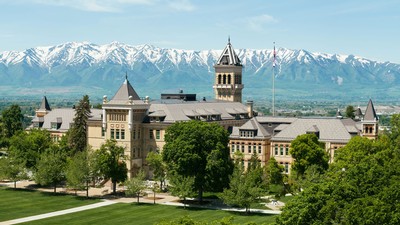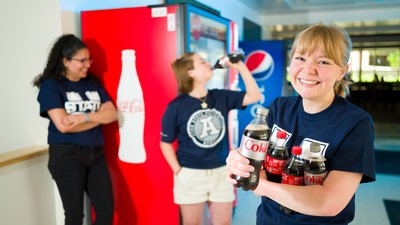Stepping Stones to Healing: Aspiring Health Care, Veterinary Scholars Explore Biological Research
Participants in USU's 2022 Native American Summer Mentorship Program to present research projects Tuesday, June 14.
By Mary-Ann Muffoletto |
From left, 2022 Native American Summer Mentorship Program participants Shailyn Parrish and Malika Isabelle Oldman learn lab techniques from Biology and Ecology Center Professor Carol von Dohlen and doctoral student Meg Licht. (M. Muffoletto photo)
Having grown up around horses, cattle, sheep and goats, Utah State University Blanding scholar Shailyn Parrish has few qualms around large animals. But the thought of collecting live bugs caused the Kayenta, Arizona native a bit of angst as she started research activities with USU Biology and Ecology Center Professor Carol von Dohlen.
Those fears were short-lived, however, as Parrish and Malika Isabelle Oldman, a fellow participant in USU’s 2022 Native American Summer Mentorship Program, got started with scooping up insects — with bare hands, mind you — to begin dissection, DNA extraction and polymerase chain reaction tests of the tiny critters.
“Dr. von Dohlen and her grad students showed us exactly where to look, so it wasn’t hard to find the bugs around campus,” says Parrish, an aspiring veterinarian. “I forgot to be afraid as I got interested in the research.”
Parrish and Oldman are among nine USU Blanding Aggies who’ve traveled to Logan to participate in the university’s NASMP program. Initiated in 2014, NASMP provides an immersive introduction to four-year degree programs in a wide variety of disciplines.
During their monthlong stay in Cache Valley, which started June 4 this year, students participate in campus tours, team-building activities including the USU Ropes Course, as well as research projects ranging from experimental solid mechanics for extreme temperature environments to studies of invasive plants and the neurobiology of social bonds.
Working with von Dohlen and doctoral students Meg Licht and Ashley Dederich, Parrish and Oldman explored the symbiotic relationship between sap-feeding insects, the plants on which they feed and bacteria that live inside the plants. The researchers learned that, over time, the bacterial genomes lose many genes essential for life outside the insect — sometimes even losing genes important to the insect.
Parrish says that while it’s engaging, research demands patience and persistence.
“There’s a ‘hurry-up-and-wait’ element to it,” she says. “But you have to understand that it’s a process and you have to follow specific steps to get accurate information.”
In addition to research in von Dohlen’s lab, Parrish learned about plants that are potentially harmful to cattle and other ruminants and are studied by USDA research pharmacologist Ben Green at the USU-based USDA Poisonous Plant Research Laboratory.
She said the lab had a small garden filled with examples of plants poisonous to ruminants, which she immediately recognized from her Four Corners-area home.
“But I’ve never heard of cattle having problems with these plants,” Parrish says. “So it was really interesting to learn about the effects certain plants can have on animals.”
Oldman, who is completing an associate degree in general studies, says her experiences in von Dohlen’s lab have convinced her to major in biology.
“I’m applying for training to become a medical assistant,” says Oldman, who is a certified nursing assistant with the Utah Navajo Health System. “Currently, I can provide nursing care, including taking vital signs for patients, but as a medical assistant, I’ll be able to perform more advanced clinical procedures, such as drawing blood, removing stitches and administering injections.”
Her plan is to complete a bachelor’s degree and eventually become a physician assistant.
“Both of my parents are in health care and I’ve grown up watching their acts of kindness and the gratitude from the people they help,” says the Aneth, Utah native. “They’re my heroes and I want to emulate them. I want to return to the reservation and help my people.”
Oldman, Parrish and their fellow NASMP participants will share their research experiences Tuesday, June 14, from 9-10:30 a.m. in Old Main, Room 121. All are welcome.
Biology/Ecology doctoral student Hannah Wilson serves as lead facilitator for the 2022 NASMP program, with assistance from fellow facilitators and Biology/Ecology doctoral students Savannah Atkins and Jessica Murray, as well as Instructional Technology and Learning Sciences graduate research assistants Siyu Wu and AlLisia Dawkins.
“We’ve had a really great group of NASMP students this year,” Wilson says. “They’ve all done a fantastic job.”
WRITER
Mary-Ann Muffoletto
Public Relations Specialist
College of Science
435-797-3517
maryann.muffoletto@usu.edu
CONTACT
Hannah Wilson
Lead Facilitator
Native American Summer Mentorship Program
hannah.wilson@usu.edu
TOPICS
Statewide Campuses 360stories Inclusive Excellence 259stories Ecology 174stories Biology 170storiesComments and questions regarding this article may be directed to the contact person listed on this page.







